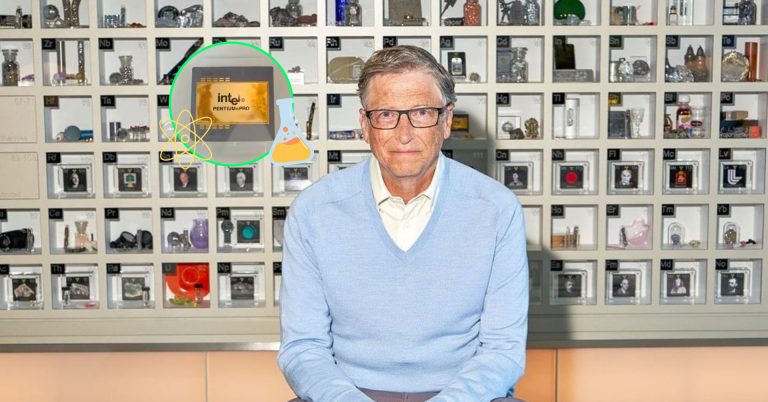
The last few years have been turbulent for Intel, a company that once reigned supreme in the semiconductor industry. Once the undisputed leader in microprocessors, Intel has faced a series of setbacks, losing ground to competitors like AMD, Nvidia, and TSMC. The situation has been so dire that even Microsoft co-founder Bill Gates, who has long had a close relationship with the chip giant, recently remarked that Intel has “lost its way.”
In a recent interview with the Associated Press, Gates reflected on Intel’s historic role in shaping the personal computing industry. He acknowledged that the company’s groundbreaking work, beginning with the introduction of the Intel 4004 in 1971, was instrumental in the rise of Microsoft and the broader PC revolution. However, he noted with disappointment how the once-dominant chipmaker has struggled to keep up with its rivals.
For decades, Intel maintained its leadership by consistently pushing the boundaries of chip design and fabrication. But in recent years, the company has faltered, failing to transition smoothly from one node to the next. The prolonged delays in moving from the 14nm process to 10nm, and later the setbacks with its 7nm node, severely impacted its competitiveness. Meanwhile, its rivals surged ahead.
Register for Tekedia Mini-MBA edition 19 (Feb 9 – May 2, 2026): big discounts for early bird.
Tekedia AI in Business Masterclass opens registrations.
Join Tekedia Capital Syndicate and co-invest in great global startups.
Register for Tekedia AI Lab: From Technical Design to Deployment (next edition begins Jan 24 2026).
Intel’s struggles extend beyond manufacturing delays. The company has consistently lost market share to AMD, which has produced increasingly competitive processors. Apple’s decision to abandon Intel in favor of its own in-house silicon was another significant blow. Furthermore, Intel has grappled with security vulnerabilities, issues with its Raptor Lake processors, and the growing dominance of TSMC and Nvidia in key areas like AI chips and GPU acceleration.
Financial Woes and Leadership Changes
Intel’s misfortunes have also translated into financial struggles. Revenue declines and investor concerns led to the ousting of CEO Pat Gelsinger last year. Gates, however, had words of praise for Gelsinger, calling him “brave” for attempting to fix both the design and fabrication sides of Intel’s business. He expressed hope that Gelsinger could turn things around but admitted that Intel’s recovery looks increasingly difficult.
“I am stunned that Intel basically lost its way,” Gates remarked. “Gordon Moore always kept Intel at the state of the art. And now they are kind of behind in terms of chip design and they are kind of behind in chip fabrication.”
Intel’s competitors—TSMC, Nvidia, and Qualcomm—are now far ahead in different aspects of chip design and production. The company has also been slow to capitalize on the AI boom, missing out on key opportunities while others took the lead. Gates emphasized this, pointing out that Intel had largely failed to position itself as a dominant force in AI computing, an area that is increasingly driving the future of the tech industry.
Nowhere is Intel’s decline more evident than in the consumer CPU market, where AMD has made remarkable gains. AMD’s Ryzen processors have repeatedly outperformed Intel’s offerings in price-to-performance ratios, leading to increased adoption among consumers. The Amazon.com processor sales chart is heavily dominated by AMD, and the company continues to gain traction in international markets.
Intel’s only consolation might be that a majority of Steam survey participants (63%) still use its CPUs, but even that could change if AMD continues its aggressive push.
Could Intel Be Acquired?
With Intel struggling, speculation has grown about a potential acquisition. Broadcom and Qualcomm were rumored to be a possible buyer at one point, but funding Intel’s vast chip fabrication operations would require tens of billions of dollars. Rebuilding Intel’s competitive edge in the industry is a long-term endeavor, making any potential buyout a risky and expensive proposition.
The U.S. government has invested heavily in Intel, particularly in an effort to reduce American dependence on foreign semiconductor manufacturing. Shutting down Intel’s fabs is not an option, meaning the company will have to find a way to recover. However, with formidable rivals continuing to innovate and expand their dominance, Intel’s path to resurgence remains uncertain.
Gates’ comments reflect the growing consensus that Intel is in a precarious position. While it still retains influence and technical expertise, the industry is rapidly evolving, and the company has been slow to adapt. With AI, mobile computing, and advanced chip design driving the next wave of technological growth, Intel faces the challenge of regaining its lost momentum before it falls further behind.
Gates concluded his remarks by saying, “I hope Intel recovers, but it looks pretty tough for them at this stage.”



